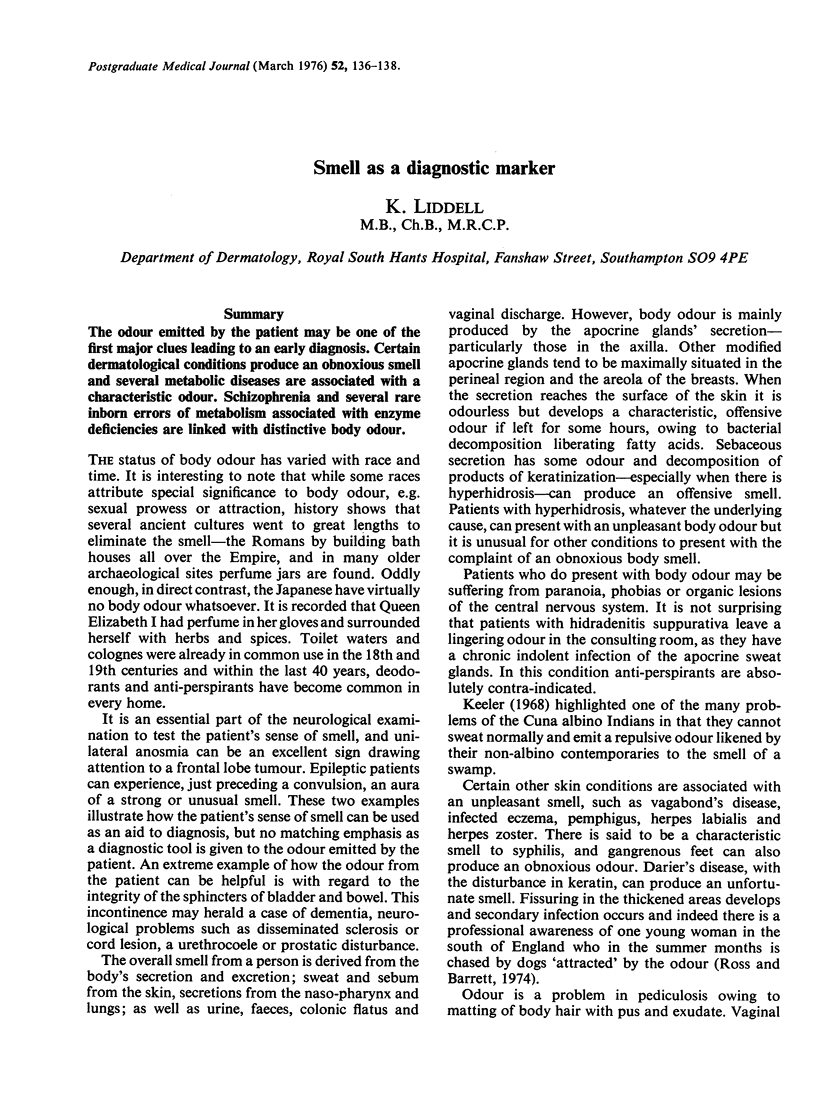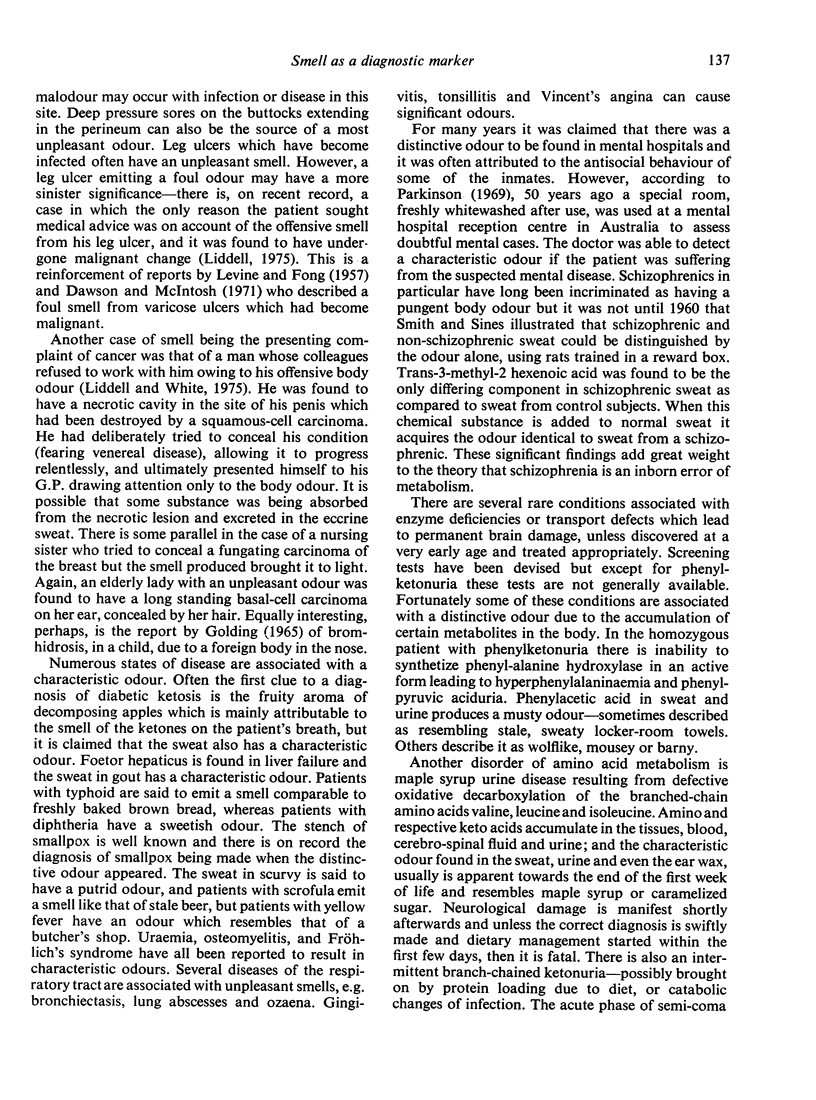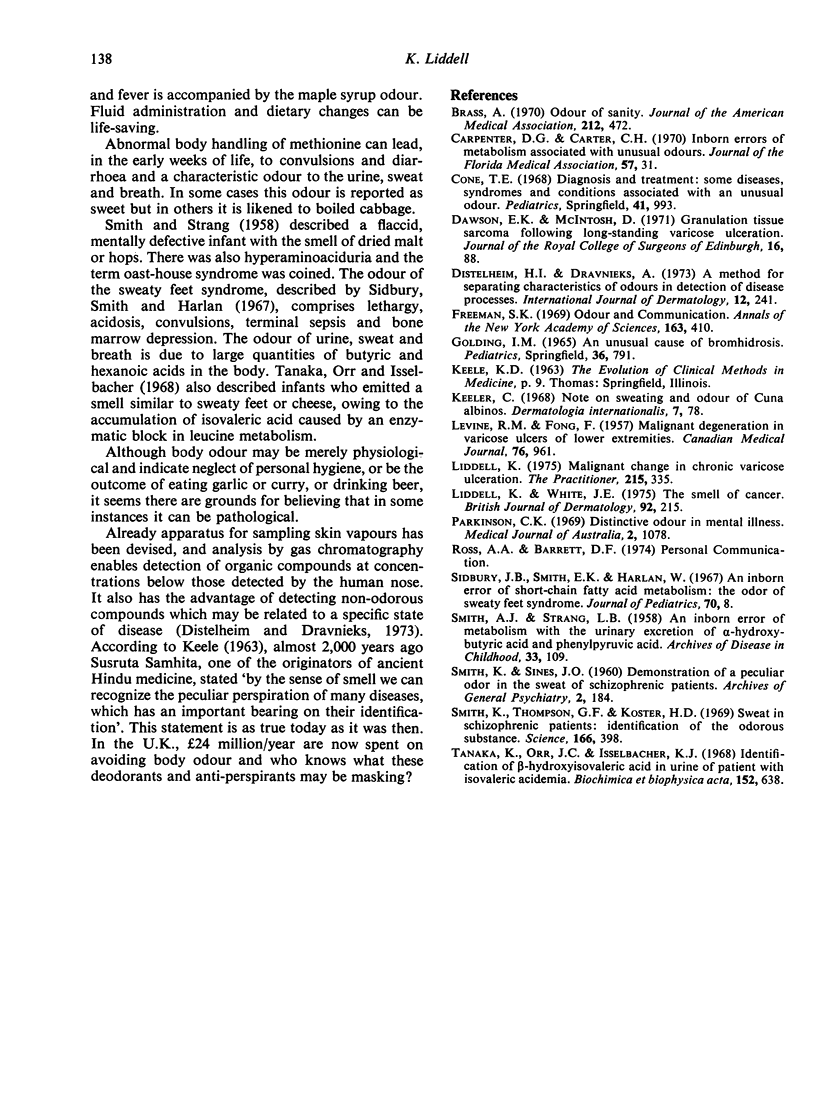Abstract
The odour emitted by the patient may be one of the first major clues leading to an early diagnosis. Certain dermatological conditions produce an obnoxious smell and several metabolic diseases are associated with a characteristic odour. Schizophrenia and several rare inborn errors of metabolism associated with enzyme deficiencies are linked with distinctive body odour.
Full text
PDF


Selected References
These references are in PubMed. This may not be the complete list of references from this article.
- Brass A. Odor of sanity. JAMA. 1970 Apr 20;212(3):472–473. doi: 10.1001/jama.212.3.472. [DOI] [PubMed] [Google Scholar]
- Carpenter D. G., Carter C. H. Inborn errors of metabolism associated with unusual odors. J Fla Med Assoc. 1970 May;57(5):31–33. [PubMed] [Google Scholar]
- Cone T. E., Jr Diagnosis and treatment: some diseases, syndromes, and conditions associated with an unusual odor. Pediatrics. 1968 May;41(5):993–995. [PubMed] [Google Scholar]
- Dawson E. K., McIntosh D. Granulation tissue sarcoma following long-standing varicose ulceration. J R Coll Surg Edinb. 1971 Mar;16(2):88–95. [PubMed] [Google Scholar]
- Distelheim I. H., Dravnieks A. A method for separating characteristics of odors in detection of disease processes. I. Int J Dermatol. 1973 Jul-Aug;12(4):241–244. doi: 10.1111/j.1365-4362.1973.tb00043.x. [DOI] [PubMed] [Google Scholar]
- Golding I. M. An unusual cause of bromidrosis. Pediatrics. 1965 Nov;36(5):791–792. [PubMed] [Google Scholar]
- LEVINE R. M., FONG F. L. Malignant degeneration in varicose ulcers of lower extremities. Can Med Assoc J. 1957 Jun 1;76(11):961–962. [PMC free article] [PubMed] [Google Scholar]
- Liddell K. Malignant change in chronic varicose ulceration. Practitioner. 1975 Sep;215(1287):335–339. [PubMed] [Google Scholar]
- Liddell K., White J. The smell of cancer. Br J Dermatol. 1975 Feb;92(2):215–217. doi: 10.1111/j.1365-2133.1975.tb03062.x. [DOI] [PubMed] [Google Scholar]
- Parkinson C. K. Distinctive odour in mental illness. Med J Aust. 1969 Nov 22;2(21):1078–1078. doi: 10.5694/j.1326-5377.1969.tb107610.x. [DOI] [PubMed] [Google Scholar]
- SMITH A. J., STRANG L. B. An inborn error of metabolism with the urinary excretion of alpha-hydroxy-butyric acid and phenylpyruvic acid. Arch Dis Child. 1958 Apr;33(168):109–113. doi: 10.1136/adc.33.168.109. [DOI] [PMC free article] [PubMed] [Google Scholar]
- SMITH K., SINES J. O. Demonstration of a peculiar odor in the sweat of schizophrenic patients. AMA Arch Gen Psychiatry. 1960 Feb;2:184–188. doi: 10.1001/archpsyc.1960.03590080060010. [DOI] [PubMed] [Google Scholar]
- Sidbury J. B., Jr, Smith E. K., Harlan W. An inborn error of short-chain fatty acid metabolism. The odor-of-sweaty-feet syndrome. J Pediatr. 1967 Jan;70(1):8–15. doi: 10.1016/s0022-3476(67)80160-4. [DOI] [PubMed] [Google Scholar]
- Smith K., Thompson G. F., Koster H. D. Sweat in schizophrenic patients: identification of the odorous substance. Science. 1969 Oct 17;166(3903):398–399. doi: 10.1126/science.166.3903.398. [DOI] [PubMed] [Google Scholar]


